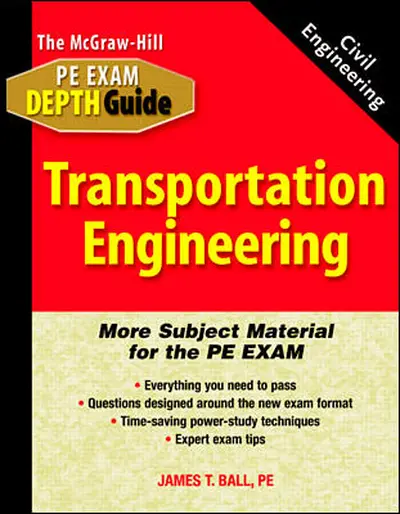My Account Details

ISBN10: 0071361804 | ISBN13: 9780071361804

Step 1 . Download Adobe Digital Editions to your PC or Mac desktop/laptop.
Step 2. Register and authorize your Adobe ID (optional). To access your eBook on multiple devices, first create an Adobe ID at account.adobe.com. Then, open Adobe Digital Editions, go to the Help menu, and select "Authorize Computer" to link your Adobe ID.
Step 3. Open Your eBook. Use Adobe Digital Editions to open the file. If the eBook doesn’t open, contact customer service for assistance.
Publisher's Note: Products purchased from Third Party sellers are not guaranteed by the publisher for quality, authenticity, or access to any online entitlements included with the product POWER TO PASS THE PE DEPTH EXAM Everything you need to pass the Transportation Engineering Depth Exam!Focused, intense, powerful, and complete—built on the experience of engineering legend McGraw-Hill—this expert study guide helps you succeed on the PE Transportation Engineering Depth Exam with less study time. McGraw-Hill Civil Engineering PE Exam Depth Guide: Transportation Engineering is the engineer’s most potent weapon for conquering the PE Depth Exam *Coverage of all subjects you need to pass *Special Depth Exam test-taking techniques THE BEST STUDY PARTNER YOU CAN FIND FOR DEPTH EXAM SUCCESS *Get to know material on the actual exam *Practice with exam-specific problems *Build confidence, skills, and knowledge *Study smarter in less time Only McGraw-Hill’s PE Exam Depth Guides deliver exam-passing confidence based on a century of engineering experience. Great for course review, too! This Transportation Engineering PE Exam Depth Guide focuses on the material that’s on the test so you'll be ready with the right skills and answers. Open this guide and start preparing for success!
Chapter 1: Horizontal and Vertical Alignment. Chapter 2: Earthwork. Chapter 3: Drainage. Chapter 4: Protection of the Environmental. Chapter 5: Roadway Design. Chapter 6: Traffic Estimation and Design Volumes. Chapter 7: Freeway and Interchange Design. Chapter 8: Pavement Base. Chapter 9: Rigid Pavement Design. Chapter 10: Flexible Pavement Design. Chapter 11: Airport Pavements. Chapter 12: Retaining Walls. Chapter 13: Highway-Railroad Crossings. Chapter 14: Bicycle Facilities. Chapter 15: Transit. Chapter 16: Railway Engineering. Chapter 17: Pedestrian Facilities. Chapter 18: Right-of-Way. Chapter 19: Traffic Management.
Chapter 3: Drainage. Chapter 4: Protection of the Environmental. Chapter 5: Roadway Design. Chapter 6: Traffic Estimation and Design Volumes. Chapter 7: Freeway and Interchange Design. Chapter 8: Pavement Base. Chapter 9: Rigid Pavement Design. Chapter 10: Flexible Pavement Design. Chapter 11: Airport Pavements. Chapter 12: Retaining Walls. Chapter 13: Highway-Railroad Crossings. Chapter 14: Bicycle Facilities. Chapter 15: Transit. Chapter 16: Railway Engineering. Chapter 17: Pedestrian Facilities. Chapter 18: Right-of-Way. Chapter 19: Traffic Management.
Chapter 5: Roadway Design. Chapter 6: Traffic Estimation and Design Volumes. Chapter 7: Freeway and Interchange Design. Chapter 8: Pavement Base. Chapter 9: Rigid Pavement Design. Chapter 10: Flexible Pavement Design. Chapter 11: Airport Pavements. Chapter 12: Retaining Walls. Chapter 13: Highway-Railroad Crossings. Chapter 14: Bicycle Facilities. Chapter 15: Transit. Chapter 16: Railway Engineering. Chapter 17: Pedestrian Facilities. Chapter 18: Right-of-Way. Chapter 19: Traffic Management.
Chapter 7: Freeway and Interchange Design. Chapter 8: Pavement Base. Chapter 9: Rigid Pavement Design. Chapter 10: Flexible Pavement Design. Chapter 11: Airport Pavements. Chapter 12: Retaining Walls. Chapter 13: Highway-Railroad Crossings. Chapter 14: Bicycle Facilities. Chapter 15: Transit. Chapter 16: Railway Engineering. Chapter 17: Pedestrian Facilities. Chapter 18: Right-of-Way. Chapter 19: Traffic Management.
Chapter 9: Rigid Pavement Design. Chapter 10: Flexible Pavement Design. Chapter 11: Airport Pavements. Chapter 12: Retaining Walls. Chapter 13: Highway-Railroad Crossings. Chapter 14: Bicycle Facilities. Chapter 15: Transit. Chapter 16: Railway Engineering. Chapter 17: Pedestrian Facilities. Chapter 18: Right-of-Way. Chapter 19: Traffic Management.
Chapter 11: Airport Pavements. Chapter 12: Retaining Walls. Chapter 13: Highway-Railroad Crossings. Chapter 14: Bicycle Facilities. Chapter 15: Transit. Chapter 16: Railway Engineering. Chapter 17: Pedestrian Facilities. Chapter 18: Right-of-Way. Chapter 19: Traffic Management.
Chapter 13: Highway-Railroad Crossings. Chapter 14: Bicycle Facilities. Chapter 15: Transit. Chapter 16: Railway Engineering. Chapter 17: Pedestrian Facilities. Chapter 18: Right-of-Way. Chapter 19: Traffic Management.
Chapter 15: Transit. Chapter 16: Railway Engineering. Chapter 17: Pedestrian Facilities. Chapter 18: Right-of-Way. Chapter 19: Traffic Management.
Chapter 17: Pedestrian Facilities. Chapter 18: Right-of-Way. Chapter 19: Traffic Management.
Chapter 19: Traffic Management.
Need support? We're here to help - Get real-world support and resources every step of the way.